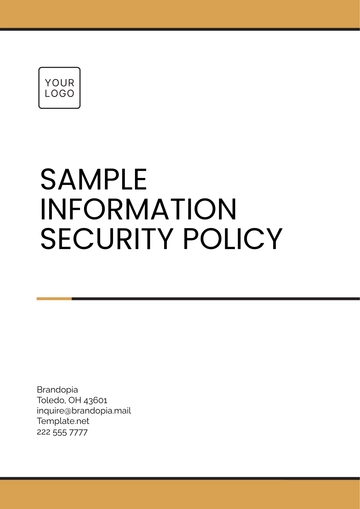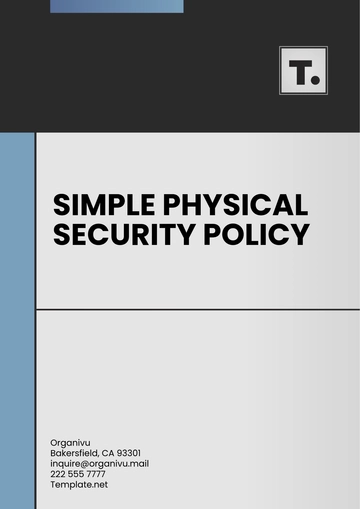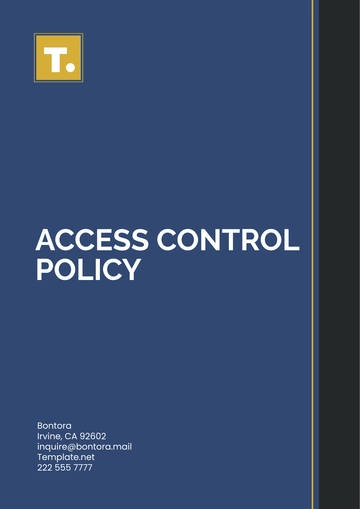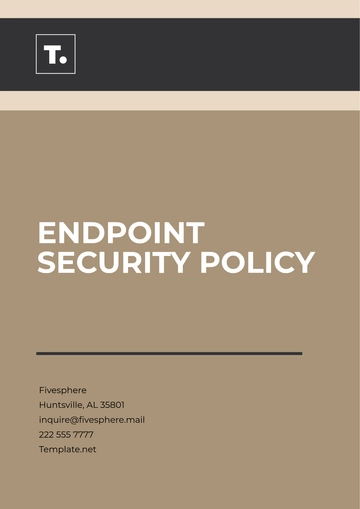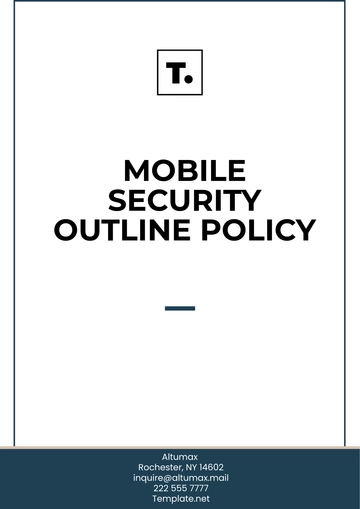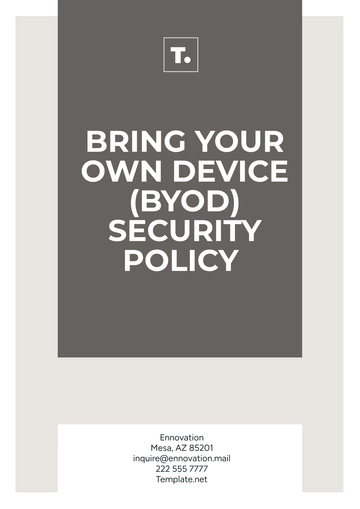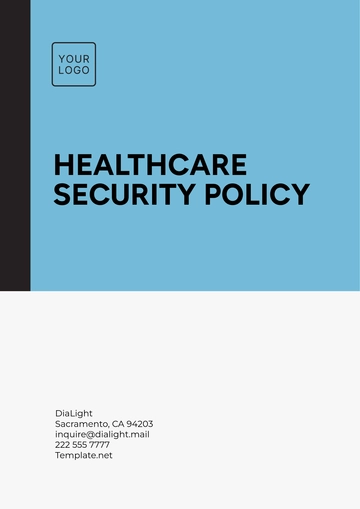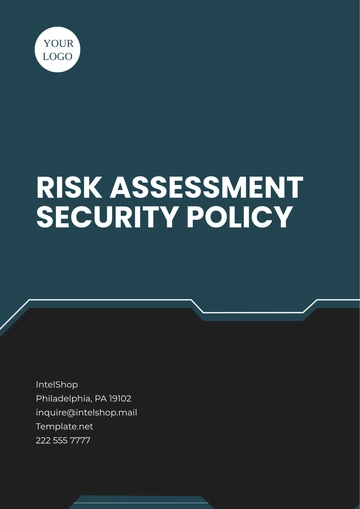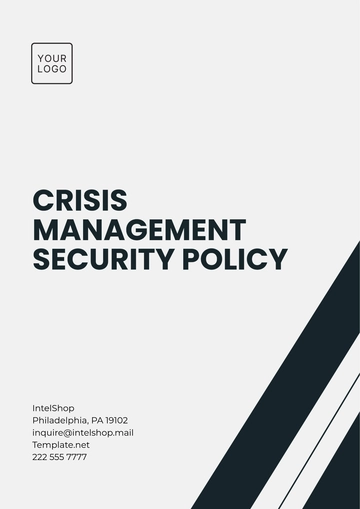Free Agriculture Security Policy
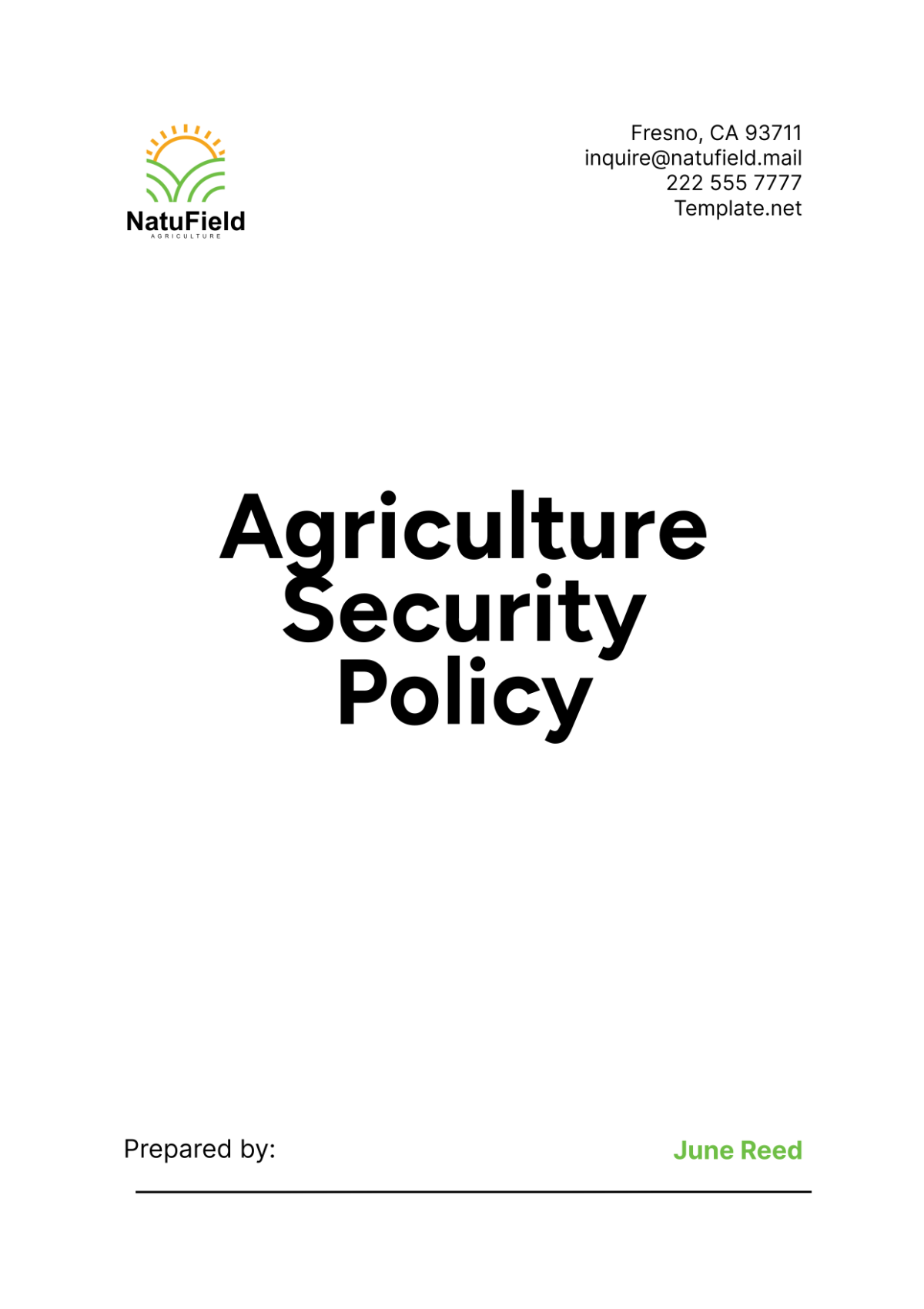
I. Introduction
A. Purpose
The purpose of this Agriculture Security Policy is to establish comprehensive security measures to safeguard [Your Company Name]'s agricultural assets, including crops, livestock, equipment, and personnel. Given the growing threats to agriculture, such as theft, vandalism, and cyber-attacks, it is crucial to have a robust security framework in place. This policy outlines the strategies and procedures to mitigate risks, prevent unauthorized access, and ensure the integrity and safety of our agricultural operations. By implementing this policy, we aim to enhance the resilience of our agricultural activities and ensure the continuity of our operations in the face of potential security threats.
B. Scope
This policy applies to all employees, contractors, and stakeholders involved in the agricultural activities of [Your Company Name]. It covers all aspects of security, including physical security, cybersecurity, personnel security, and emergency response. The scope of this policy extends to all agricultural sites, facilities, and equipment owned or operated by [Your Company Name]. It also encompasses digital assets and data related to agricultural operations. The policy is designed to be comprehensive, addressing both current and emerging threats to our agricultural infrastructure.
C. Objectives
To protect agricultural assets from theft, vandalism, and other security threats. This involves implementing physical security measures such as fencing, surveillance, and controlled access.
To ensure the safety of personnel involved in agricultural operations. This includes providing training on security protocols and ensuring a safe working environment.
To safeguard sensitive agricultural data from unauthorized access and cyber threats. This involves implementing cybersecurity measures such as encryption, access controls, and regular security assessments.
To establish effective emergency response protocols in case of security incidents. This includes developing incident management plans, conducting regular drills, and ensuring clear communication channels during emergencies.
II. Physical Security
A. Site Security
Perimeter Fencing
1.1 All agricultural sites must be enclosed with sturdy fencing to deter unauthorized access. The fencing should be at least 8 feet high and made of durable materials such as chain-link or reinforced steel. This helps to create a physical barrier that prevents intruders from easily accessing the site.
1.2 Regular inspections of the fencing must be conducted monthly to identify and repair any damage promptly. Any breaches or weaknesses in the fencing should be addressed immediately to maintain the security of the site.
Access Control
2.1 Entry points to agricultural sites must be equipped with controlled access systems, including gates with electronic locks and surveillance cameras. This ensures that only authorized personnel can enter the site.
2.2 Only authorized personnel are permitted to access these sites. Access credentials must be issued and managed by the security department. The credentials should be reviewed and updated regularly to ensure they remain secure.
B. Surveillance
CCTV Cameras
1.1 Closed-circuit television (CCTV) cameras must be installed at strategic locations across all agricultural sites to monitor activities 24/7. These cameras should cover all critical areas, including entry points, storage facilities, and livestock pens.
1.2 Footage from CCTV cameras must be stored for a minimum of 30 days and reviewed regularly for any suspicious activities. This helps in identifying and investigating security incidents promptly.
Lighting
2.1 Adequate lighting must be installed around the perimeter and critical areas of agricultural sites to deter unauthorized access and enhance visibility. This includes both fixed and motion-activated lights.
2.2 Motion-activated lights should be used to save energy and alert security personnel of any movement in restricted areas. These lights should be positioned to cover all entry points and areas where valuable assets are stored.
C. Equipment Security
Inventory Management 1
1.1 All agricultural equipment must be inventoried and tagged with unique identification numbers for tracking purposes. This helps in keeping track of all equipment and prevents loss or theft.
1.2 Regular audits of equipment must be conducted quarterly to ensure all items are accounted for. Any discrepancies should be investigated and addressed promptly.
Storage
2.1 Equipment not in use must be stored in secure, locked facilities. These facilities should be monitored with CCTV cameras and access-controlled to prevent unauthorized access.
2.2 Maintenance checks must be conducted monthly to ensure equipment is in good working condition and ready for use. Any equipment found to be faulty should be repaired or replaced immediately.
III. Cybersecurity
A. Data Protection
Data Encryption
1.1 All sensitive agricultural data, including research, crop management plans, and financial records, must be encrypted both at rest and in transit. This ensures that even if data is intercepted, it cannot be read without the encryption keys.
1.2 Encryption keys must be stored securely and managed by the IT department. Access to these keys should be restricted to authorized personnel only.
Access Control
2.1 Access to sensitive agricultural data must be restricted to authorized personnel only. Multi-factor authentication (MFA) must be implemented for accessing critical systems to provide an additional layer of security.
2.2 Regular audits of access logs must be conducted to detect and respond to any unauthorized access attempts. Any anomalies should be investigated and addressed promptly.
B. Network Security
Firewalls and Intrusion Detection Systems
1.1 Firewalls and intrusion detection systems (IDS) must be deployed to protect agricultural networks from external threats. These systems should be configured to detect and block suspicious activities.
1.2 Security updates and patches must be applied promptly to all network devices to mitigate vulnerabilities. This helps in preventing attackers from exploiting known weaknesses.
Regular Security Assessments
2.1 Periodic security assessments, including penetration testing and vulnerability scanning, must be conducted to identify and address potential cybersecurity risks. These assessments should be performed by qualified security professionals.
2.2 Findings from security assessments must be documented, and remediation plans must be implemented within a specified timeframe. Progress on remediation efforts should be monitored and reported regularly.
C. Employee Training
Cybersecurity Awareness
1.1 All employees must undergo regular cybersecurity awareness training to recognize and respond to potential threats such as phishing and malware. This training should cover the latest threat trends and best practices for staying secure online.
1.2 Training sessions must be conducted annually, and employees must complete a knowledge assessment to ensure understanding. Records of training completion should be maintained and reviewed regularly.
Incident Reporting
2.1 A clear procedure for reporting cybersecurity incidents must be established. Employees must be encouraged to report any suspicious activities or security breaches immediately to the IT department.
2.2 Incident response teams must be formed to investigate and mitigate reported incidents promptly. These teams should be trained and equipped to handle a wide range of cybersecurity threats.
IV. Personnel Security
A. Employee Vetting
Background Checks
1.1 Comprehensive background checks must be conducted for all new hires involved in agricultural operations. This includes criminal history, employment verification, and reference checks. These checks help ensure that employees do not pose a security risk.
1.2 Background checks must be repeated every five years for existing employees. This ensures that any new issues that may arise are identified and addressed.
Security Training
2.1 All employees must receive security training upon hiring and attend refresher courses annually. Training should cover physical security, cybersecurity, and emergency response to ensure employees are well-prepared for any security challenges.
2.2 Records of training completion must be maintained and reviewed regularly to ensure compliance. Any gaps in training should be addressed promptly to maintain a high level of security awareness.
B. Visitor Management
Visitor Registration
1.1 All visitors to agricultural sites must be registered at the main entrance and issued temporary access badges. This helps in keeping track of who is on the site at any given time.
1.2 Visitors must be escorted by authorized personnel at all times and are not permitted to access restricted areas. This prevents unauthorized individuals from accessing sensitive areas.
Monitoring and Reporting
2.1 A log of all visitors must be maintained, including the purpose of the visit and the areas accessed. This log should be reviewed regularly to identify any unusual patterns.
2.2 Any suspicious behavior by visitors must be reported immediately to the security department for investigation. Prompt reporting and investigation help in addressing potential security threats before they escalate.
V. Emergency Response
A. Incident Management
Incident Reporting
1.1 A standardized incident reporting system must be implemented to document and respond to security incidents promptly. This system should be accessible to all employees.
1.2 All incidents must be reported to the security department within 24 hours of occurrence. This ensures that incidents are addressed quickly to minimize impact.
Response Teams
2.1 Designated response teams must be established for different types of incidents, including theft, vandalism, and natural disasters. These teams should include members with relevant expertise and training.
2.2 Response teams must undergo regular training and drills to ensure preparedness for actual incidents. This helps in ensuring that team members are familiar with their roles and responsibilities during an incident.
B. Communication Protocols
Internal Communication
1.1 Clear communication protocols must be established for notifying employees of security incidents and providing instructions for response. These protocols should be designed to ensure that information is communicated quickly and effectively.
1.2 Regular communication drills must be conducted to ensure all employees are familiar with the protocols. These drills should simulate various types of incidents to test the effectiveness of the communication procedures.
External Communication
2.1 Communication with external agencies, such as law enforcement and emergency services, must be pre-established to ensure swift coordination during incidents. This includes having contact information readily available and establishing protocols for reaching out to these agencies.
2.2 Contact information for external agencies must be maintained and updated regularly. This ensures that in the event of an incident, the appropriate agencies can be contacted quickly.
C. Recovery and Continuity
Business Continuity Planning
1.1 A comprehensive business continuity plan must be developed to ensure the continuity of agricultural operations in the event of a major incident. This plan should outline the steps to be taken to resume operations as quickly as possible.
1.2 The plan must be reviewed and updated annually to address new risks and changes in operations. This ensures that the plan remains relevant and effective in addressing current threats.
Post-Incident Analysis
2.1 After any security incident, a thorough analysis must be conducted to identify the root cause and implement corrective actions. This analysis should be documented and reviewed by relevant stakeholders.
2.2 Lessons learned from incidents must be documented and shared with relevant stakeholders to prevent recurrence. This helps in continuously improving the security measures and protocols in place.
VI. Compliance and Auditing
A. Regulatory Compliance
Legal Requirements
1.1 [Your Company Name] must comply with all relevant local, state, and federal regulations pertaining to agricultural security. This includes regulations related to the handling of hazardous materials, animal welfare, and data protection.
1.2 Regular reviews of regulatory requirements must be conducted to ensure ongoing compliance. This helps in identifying any changes in regulations and updating the security measures accordingly.
Industry Standards
2.1 Adherence to industry standards and best practices for agricultural security must be maintained. This includes standards related to physical security, cybersecurity, and emergency response.
2.2 Participation in industry forums and working groups is encouraged to stay informed of evolving standards. This helps in ensuring that the security measures remain up-to-date and effective.
B. Internal Audits
Audit Schedule
1.1 Internal security audits must be conducted biannually to assess compliance with this policy and identify areas for improvement. These audits should be conducted by qualified internal auditors.
1.2 Audit findings must be documented, and corrective actions must be implemented within 60 days. Progress on corrective actions should be monitored and reported regularly.
Audit Reporting
2.1 A detailed report of audit findings must be submitted to senior management and the board of directors. This helps in ensuring that management is aware of any security issues and the steps being taken to address them.
2.2 Progress on corrective actions must be monitored and reported quarterly. This ensures that any issues identified during audits are addressed in a timely manner.
C. Continuous Improvement
Feedback Mechanisms
1.1 A system for receiving and addressing feedback on the security policy and its implementation must be established. This system should be accessible to all employees and stakeholders.
1.2 Employees must be encouraged to provide feedback on security practices and suggest improvements. This helps in continuously improving the security measures and protocols in place.
Policy Review
2.1 This Agriculture Security Policy must be reviewed and updated annually to ensure its continued relevance and effectiveness. This review should be conducted by the security department in collaboration with other relevant departments.
2.2 Changes to the policy must be communicated to all employees and stakeholders. This ensures that everyone is aware of the latest security measures and protocols.
VII. Conclusion
A. Commitment to Security
[Your Company Name] is committed to maintaining a secure and safe environment for all agricultural operations. The implementation of this Agriculture Security Policy is a testament to our dedication to protecting our assets, personnel, and data from security threats. We recognize that security is a critical component of our operations and are committed to continuously improving our security measures to address evolving threats.
B. Continuous Vigilance
Security is an ongoing process that requires continuous vigilance and adaptation to emerging threats. [Your Company Name] will remain proactive in enhancing our security measures and ensuring that our agricultural operations are resilient and secure. This includes staying informed of the latest security trends, investing in new security technologies, and fostering a culture of security awareness among our employees.
- 100% Customizable, free editor
- Access 1 Million+ Templates, photo’s & graphics
- Download or share as a template
- Click and replace photos, graphics, text, backgrounds
- Resize, crop, AI write & more
- Access advanced editor
Ensure farm safety with the Agriculture Security Policy Template from Template.net. This editable tool establishes protocols. Use our Ai Editor Tool to customize policies, safeguarding assets and personnel in agricultural operations.
You may also like
- HR Policy
- Restaurant Policy
- Company Policy
- Accounting Policies and Procedures
- Website Policy
- Privacy Policy
- Safety Policy
- School Policy
- IT and Software Policy
- Law Firm Policy
- Construction Policy
- Interior Design Policy
- Travel Agency Policy
- Education Academic Policy
- Security Policy
- Real Estate Policy
- Expense Policy
- Software Policy

